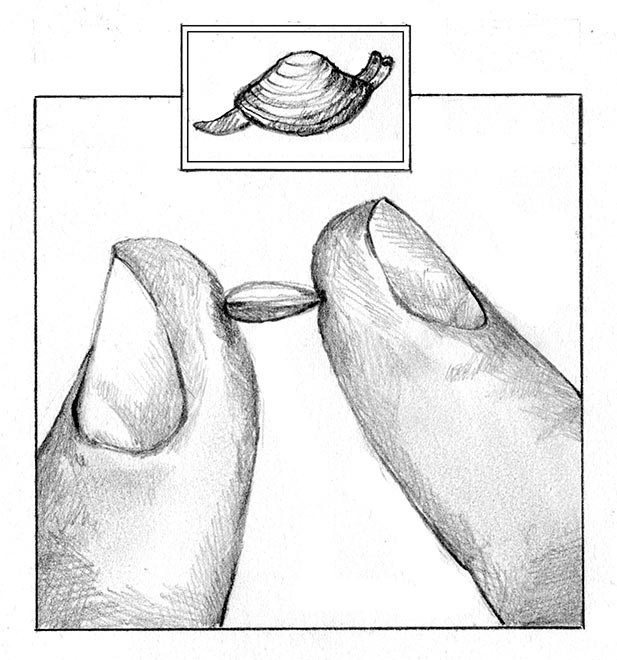
Clambakes, fried clams, clam diggers, clam shacks ― we usually associate clams with the ocean. You may have also seen freshwater clams in rivers and lakes. But did you know there are clams that live in the woods?
In our region, there are several species of fingernail clam that inhabit vernal pools, the temporary woodland pools where frogs and salamanders lay their eggs in the spring. As temperatures warm and melting snow and rain fill depressions in the forest floor, these small clams, only the size and shape of a child’s fingernail, become active.
A fingernail clam moves slowly along the murky bottom of a vernal pool and burrows in the mud by extending and contracting its foot, a muscular appendage. To breathe, it extracts oxygen from the water with gills. An efficient filter-feeder, the clam sucks up the rich soup of the pool through a tubular siphon, filtering out food particles, namely algae and bits of leaf litter that were broken down by other leaf-eaters. Wastewater is expelled from another siphon.
Late in the spring, usually in June, fingernail clams reproduce. According to Steve Faccio, a conservation biologist with the Vermont Center for Ecostudies, “the sheer number of fingernail clams can be dramatic at this time. Thousands of these young clams may cover the bottoms of pools and you can scoop up dozens in a handful.”
Fingernail clams are hermaphrodites; both male and female sex organs are found in the same individual, explained Jim Kellogg, an aquatic biologist with the Vermont Department of Environmental Conservation. The eggs are fertilized and tiny clams grow inside the parent until they are released. Kellogg described opening a fingernail clam and seeing the little clams inside.
When summer comes and vernal pools dry up, the young clams burrow deep down in the muck and enter diapause ― their development is put on hold. However, if the pool refills with water from autumn rains, the clams will become active again.
They follow the same strategy to survive the winter. Fingernail clams have been found overwintering as deep as eight inches underground, having dug more than sixteen times their body length.
According to Faccio, fingernail clams are common in vernal pools in both Vermont and New Hampshire, especially in pools with a lot of leaf litter. He has found them in pools beneath a sunny, open woodland canopy and in pools in dense, dark forest. Some species also inhabit other temporary wetlands and even roadside ditches. Kellogg says fingernail clams need adequate levels of calcium in the bedrock and soil to build their shells, and are usually found in water of at least a neutral pH. However, they are not as fussy as other freshwater clams in this respect, and he has found a few living under slightly acidic conditions.
These tiny clams provide food for other residents of vernal pools, such as snails, and visitors like salamanders, raccoons, and shorebirds. No one knows for sure how they disperse to other vernal pools. They cannot move very far on their own. One theory is that the clams attach to the fur or feathers of mink, ducks, or other travelers, and hitch a ride to other pools. Another idea is that ducks feeding on vegetation in vernal pools accidentally ingest the clams and later regurgitate or eliminate them whole in a different location.
Look for fingernail clams this spring in woodland vernal pools. Put your hand in the water and lift up a few of the dead leaves on the bottom, watching for glossy off-white shells. Or, if you’re walking in the woods next fall and come upon little clamshells in the dry leaf litter, make a note of the location. Chances are, come spring, a vernal pool will appear there.


Discussion *